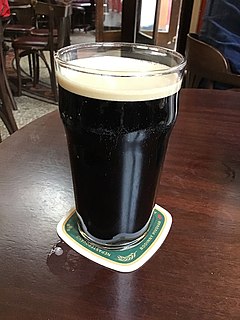
Mild ale is a type of ale, with a predominantly malty palate. Modern mild ales are mainly dark-coloured with an alcohol by volume (ABV) of 3% to 3.6%, although there are lighter-hued examples as well as stronger examples reaching 6% abv and higher. It originated in Britain in the 17th century or earlier, and originally meant a young ale, as opposed to a "stale" aged or old ale. It is now more often interpreted as being mildly hopped.

Stout is a dark, top-fermented beer with a number of variations, including dry stout, oatmeal stout, milk stout, and imperial stout.

Hávamál is presented as a single poem in the Codex Regius, a collection of Old Norse poems from the Viking age. The poem, itself a combination of numerous shorter poems, is largely gnomic, presenting advice for living, proper conduct and wisdom. It is considered an important source of Old Norse philosophy.

Þrúðr, sometimes anglicized as Thrúd or Thrud, is a daughter of the major god Thor and the goddess Sif in Norse mythology. Þrúðr is also the name of one of the valkyries who serve ale to the einherjar in Valhalla. The two may or may not be the same figure.

Dagr is the divine personification of the day in Norse mythology. He appears in the Poetic Edda, compiled in the 13th century from earlier traditional sources, and the Prose Edda, written in the 13th century by Snorri Sturluson. In both sources, Dagr is stated to be the son of the god Dellingr and is associated with the bright-maned horse Skinfaxi, who "draw[s] day to mankind". Depending on manuscript variation, the Prose Edda adds that Dagr is either Dellingr's son by Nótt, the personified night, or Jörð, the personified Earth. Otherwise, Dagr appears as a common noun simply meaning "day" throughout Old Norse works. Connections have been proposed between Dagr and other similarly named figures in Germanic mythology.
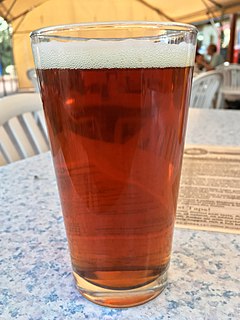
Pale ale is a typically golden to amber coloured style of ale which is brewed using an ale yeast and predominantly pale malt. The term first appeared around 1703 for beers made from malts dried with high-carbon coke, which resulted in a lighter colour than other beers popular at that time. Different brewing practices and hop quantities have resulted in a range of tastes and strengths within the pale ale family.
Rhyme royal is a rhyming stanza form that was introduced to English poetry by Geoffrey Chaucer. The form enjoyed significant success in the fifteenth century and into the sixteenth century. It has had a more subdued but continuing influence on English verse in more recent centuries.
Richard Holland or Richard de Holande was a Scottish cleric and poet, author of the Buke of the Howlat.
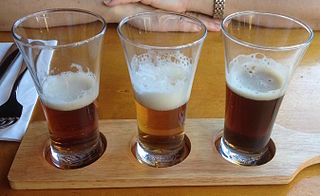
Beer styles differentiate and categorise beers by colour, flavour, strength, ingredients, production method, recipe, history, or origin.
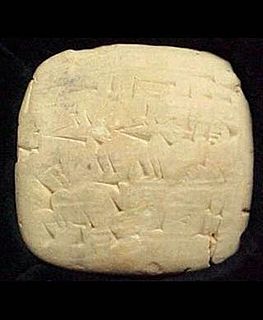
Beer is one of the oldest drinks humans have produced. The first chemically confirmed barley beer dates back to the 5th millennium BC in modern-day Iran, and was recorded in the written history of ancient Egypt and Mesopotamia and spread throughout the world.
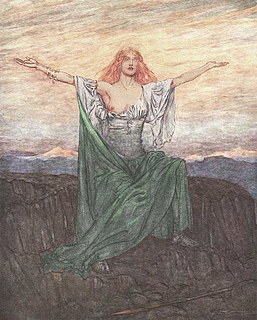
Sigrdrífumál is the conventional title given to a section of the Poetic Edda text in Codex Regius.

The Flyting of Dunbar and Kennedie is the earliest surviving example of the Scottish version of the flyting genre in poetry. The genre takes the form of a contest, or "war of words", between two poets, each trying to outclass the other in vituperation and verbal pyrotechnics. It is not certain how the work was composed, but it is likely to have been publicly performed, probably in the style of a poetic joust by the two combatants, William Dunbar and Walter Kennedy, before the Court of James IV of Scotland.
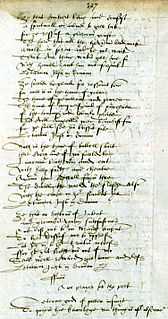
The Bannatyne Manuscript is an anthology of literature compiled in Scotland in the sixteenth century. It is an important source for the Scots poetry of the fifteenth and sixteenth centuries. The manuscript contains texts of the poems of the great makars, many anonymous Scots pieces and works by medieval English poets.
The Three Dead Kings, is a 15th-century Middle English poem. It is found in the manuscript MS. Douce 302 in the Bodleian Library in Oxford, and its authorship is sometimes attributed to a Shropshire priest, John Audelay. It is an extremely rare survival from a late genre of alliterative verse, also significant as the only English poetic retelling of a well-known memento mori current in mediaeval European church art.

"The Taill of the Cok and the Jasp" is a Middle Scots version of Aesop's Fable The Cock and the Jewel by the 15th-century Scottish poet Robert Henryson. It is the first in Henryson's collection known as the Morall Fabillis of Esope the Phrygian. The Cok and the Jasp is framed by a prologue and a moralitas, and as the first poem in the collection it operates on a number of levels, and in all its parts, to introduce the larger cycle.

"The Twa Cummeris", also rendered as "The Twa Cumeris", is a short humorous poem in Scots written at an unknown date by William Dunbar
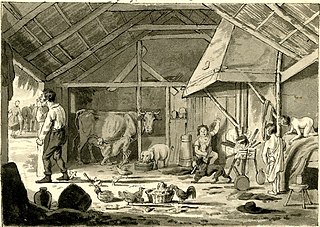
"The Wife of Auchtermuchty" is a Scots poem of the fifteenth or sixteenth centuries.

Quhy Sowld Nocht Allane Honorit Be is an anonymous allegorical poem of the fifteenth or sixteenth century written in Scots.
Claf Abercuawg is the modern title of a 32-stanza medieval Welsh englyn-poem. According to Jenny Rowland, 'most critics would classify it among the most sophisticated and moving all the early englynion poems'; it is 'the classic example' of meditative, lyric, at least implicitly religious, early Welsh poetry.
Canu Heledd are a collection of early Welsh englyn-poems. They are rare among medieval Welsh poems for being set in the mouth of a female character. One prominent figure in the poems is Heledd's dead brother Cynddylan.















